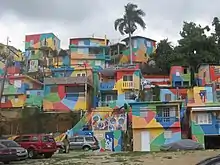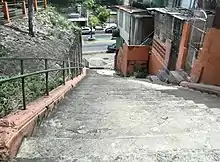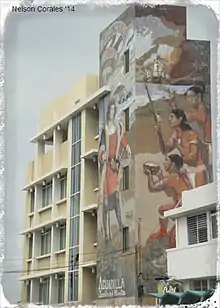Aguadilla barrio-pueblo
Aguadilla barrio-pueblo is an urban barrio and the administrative center (seat) of Aguadilla, a municipality of Puerto Rico. Its population in 2010 was 3,627.[1][4][5][6]
Aguadilla barrio-pueblo
Barrio Pueblo Aguadilla | |
|---|---|
Municipality Seat[1] | |
 Central Plaza of Aguadilla with ocean view. | |
 | |
 Aguadilla barrio-pueblo Location of Puerto Rico | |
| Coordinates: 18°25′47″N 67°09′20″W[2] | |
| Commonwealth | |
| Municipality | |
| Area | |
| • Total | 0.74 sq mi (1.9 km2) |
| • Land | 0.37 sq mi (1.0 km2) |
| • Water | 0.37 sq mi (1.0 km2) |
| Elevation | 0 ft (0 m) |
| Population (2010) | |
| • Total | 3,627 |
| • Density | 9,802.7/sq mi (3,784.8/km2) |
| Source: 2010 Census | |
| Time zone | UTC−4 (AST) |
As was customary in Spain, in Puerto Rico, the municipality has a barrio called pueblo which contains a central plaza, the municipal buildings (city hall), and a Catholic church. Fiestas patronales (patron saint festivals) are held in the central plaza every year.[7][8]
| Historical population | |||
|---|---|---|---|
| Census | Pop. | %± | |
| 1980 | 7,432 | — | |
| 1990 | 5,311 | −28.5% | |
| 2000 | 4,884 | −8.0% | |
| 2010 | 3,627 | −25.7% | |
| U.S. Decennial Census[9] 1899 (shown as 1900)[10] 1910-1930[11] 1930-1950[12] 1980-2000[13] 2010[14] | |||
The central plaza and its church
The central plaza, or square, is a place for official and unofficial recreational events and a place where people can gather and socialize from dusk to dawn. The Laws of the Indies, Spanish law, which regulated life in Puerto Rico in the early 19th century, stated the plaza's purpose was for "the parties" (celebrations, festivities) (Spanish: a propósito para las fiestas), and that the square should be proportionally large enough for the number of neighbors (Spanish: grandeza proporcionada al número de vecinos). These Spanish regulations also stated that the streets nearby should be comfortable portals for passersby, protecting them from the elements: sun and rain.[7]
The name of the church located in the plaza is Parroquía San Carlos Borromeo. Its construction began in 1776 and was completed in 1783. It was remodeled in 1855. One of its towers collapsed during the 1918 San Fermín earthquake and the facade was changed when reconstructed. Its last remodeling was in 1971.[15]
Sectors
Barrios (which are like minor civil divisions)[6] in turn are further subdivided into smaller local populated place areas/units called sectores (sectors in English). The types of sectores may vary, from normally sector to urbanización to reparto to barriada to residencial, among others.[16][17][18][19]
The following sectors are in Barrio Pueblo (Norte):[20]
Avenida Los Robles, Calle Barbosa, Calle Ceiba, Calle Duda, Calle Fuerte, Calle Reguero, Calle Stahl, Callejón del Fuerte, Cerro Juan Vega, Condominio Cuesta Vieja, El Chapey, El Perú, Joya Las Marinas, Residencial Cuesta Vieja, Residencial Puesta del Sol, Sector Cerro Los Condenados (Cuesta Vieja), Sector Cerro Reguero, Sector Cuesta Nueva, Sector Cuesta Vieja, Sector La Vía (Norte), Sector Llanos Jiménez, Sector Luquillo, and Sector Tamarindo.
The following sectors are in Barrio Pueblo (Sur y Centro):[20]
Avenida San Carlos, Barriada Visbal, Barrio Higuey, Barrio Iglesias, Calle Mercado, Calle Mercedes Moreno, Calle Progreso, Cerro Cabrera, Cerro Calero, Cerro Echevarría, Cerro Gonzalo, Condominio Torres del Sol, Condominio Villa Mar, Residencial Villamar, Salsipuedes, Santa Bárbara, Sector Campo Alegre, Sector Cerro Las Ánimas, Sector Gregorio Vélez Vaz, Sector Joyas San Carlos, and Sector La Vía (Sur).
Gallery
 Aguadilla City Hall
Aguadilla City Hall Catholic church in Aguadilla Central plaza
Catholic church in Aguadilla Central plaza Aguadilla Central plaza
Aguadilla Central plaza Colorful buildings adjacent to Aguadilla Central plaza
Colorful buildings adjacent to Aguadilla Central plaza Street art adjacent to Aguadilla Central plaza
Street art adjacent to Aguadilla Central plaza Statue of José de Diego in Aguadilla Central plaza
Statue of José de Diego in Aguadilla Central plaza Police headquarters in Aguadilla barrio-pueblo
Police headquarters in Aguadilla barrio-pueblo Wooden boat on Aguadilla waterfront road
Wooden boat on Aguadilla waterfront road Aguadilla police
Aguadilla police Hill and steps leading to La Via sector
Hill and steps leading to La Via sector Flag painted on building in Aguadilla barrio-pueblo
Flag painted on building in Aguadilla barrio-pueblo Murals painted on Aguadilla Electronic Library
Murals painted on Aguadilla Electronic Library
References
- Puerto Rico:2010:population and housing unit counts.pdf (PDF). U.S. Dept. of Commerce, Economics and Statistics Administration, U.S. Census Bureau. 2010. Archived (PDF) from the original on 2017-02-20. Retrieved 2019-01-09.
- "US Gazetteer 2019". US Census. US Government. Archived from the original on 2020-01-16. Retrieved 2020-06-24.
- U.S. Geological Survey Geographic Names Information System: Aguadilla barrio-pueblo
- Picó, Rafael; Buitrago de Santiago, Zayda; Berrios, Hector H. Nueva geografía de Puerto Rico: física, económica, y social, por Rafael Picó. Con la colaboración de Zayda Buitrago de Santiago y Héctor H. Berrios. San Juan Editorial Universitaria, Universidad de Puerto Rico,1969. Archived from the original on 2018-12-26. Retrieved 2019-01-09.
- Gwillim Law (20 May 2015). Administrative Subdivisions of Countries: A Comprehensive World Reference, 1900 through 1998. McFarland. p. 300. ISBN 978-1-4766-0447-3. Retrieved 25 December 2018.
- "US Census Barrio-Pueblo definition". factfinder.com. US Census. Archived from the original on 13 May 2017. Retrieved 5 January 2019.
- Santullano, Luis A. (10 March 2019). Mirada al Caribe. 54. Colegio de Mexico. pp. 75–78. doi:10.2307/j.ctvbcd2vs.12. JSTOR j.ctvbcd2vs.12.
- Pariser, Harry S. (2003). Explore Puerto Rico, Fifth Edition. San Francisco: Manatee Press. pp. 52–55. Retrieved 10 February 2019.
- "U.S. Decennial Census". United States Census Bureau. Archived from the original on February 13, 2020. Retrieved September 21, 2017.
- "Report of the Census of Porto Rico 1899". War Department Office Director Census of Porto Rico. Archived from the original on July 16, 2017. Retrieved September 21, 2017.
- "Table 3-Population of Municipalities: 1930 1920 and 1910" (PDF). United States Census Bureau. Archived (PDF) from the original on August 17, 2017. Retrieved September 21, 2017.
- "Table 4-Area and Population of Municipalities Urban and Rural: 1930 to 1950" (PDF). United States Census Bureau. Archived (PDF) from the original on August 30, 2015. Retrieved September 21, 2014.
- "Table 2 Population and Housing Units: 1960 to 2000" (PDF). United States Census Bureau. Archived (PDF) from the original on July 24, 2017. Retrieved September 21, 2017.
- Puerto Rico:2010:population and housing unit counts.pdf (PDF). U.S. Dept. of Commerce Economics and Statistics Administration U.S. Census Bureau. 2010. Archived (PDF) from the original on 2017-02-20. Retrieved 2019-08-02.
- Mari Mut, José A. (28 August 2013). "Los pueblos de Puerto Rico y las iglesias de sus plazas [The pueblos of Puerto Rico and the churches of its plazas]" (in Spanish). pp. 2–5. Retrieved 19 June 2020 – via archive.org.
- "Agencia: Oficina del Coordinador General para el Financiamiento Socioeconómico y la Autogestión (Proposed 2016 Budget)". Puerto Rico Budgets (in Spanish). Archived from the original on 28 June 2019. Retrieved 28 June 2019.
- Rivera Quintero, Marcia (2014), El vuelo de la esperanza : Proyecto de las Comunidades Especiales Puerto Rico, 1997-2004 (Primera edición ed.), San Juan, Puerto Rico Fundación Sila M. Calderón, ISBN 978-0-9820806-1-0
- "Leyes del 2001". Lex Juris Puerto Rico (in Spanish). Archived from the original on 14 September 2018. Retrieved 24 June 2019.
- "Comunidades Especiales de Puerto Rico" (in Spanish). 8 August 2011. Archived from the original on 24 June 2019. Retrieved 24 June 2019.
- "PRECINTO ELECTORAL AGUADILLA 035" (PDF). Comisión Estatal de Elecciones (in Spanish). PR Government. 30 January 2019. Retrieved 21 June 2020.